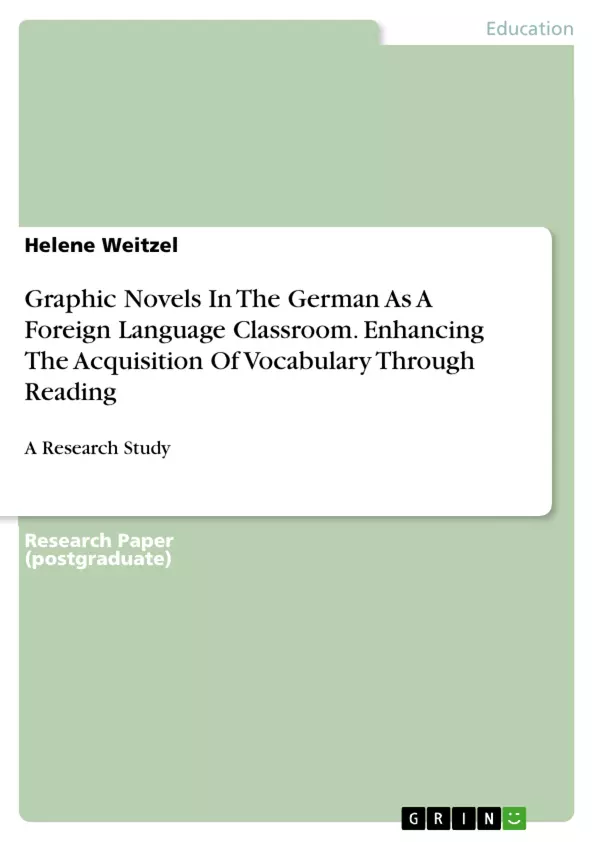This research study investigated the incidental vocabulary acquisition through reading in the German language classroom at college level. For three weeks students were asked to read a graphic novel (experimental group); the other half of the students were asked to study vocabulary as flashcards (control group). To assess their vocabulary knowledge before the experiment took place the students were tested on their existing knowledge. After three weeks the students had to take an immediate posttest that asked for the same vocabulary as the pretest. Forty frequently used German words represented the vocabulary that the participants were tested on. These words also appeared frequently in the graphic novel that the students had to read: Game of Thrones – Das Lied von Eis und Feuer. By comparing the pre- and immediate posttest results, this research study aimed at showing whether incidental vocabulary acquisition takes place through reading. The results, however, did not suggest that reading a graphic novel had a sustainable impact on incidental vocabulary acquisition. The study’s control group scored much better in their posttests than the experimental group. This implied that the former had gained new words and improved their existing vocabulary knowledge. Conversely, the experimental group scored worse indicating that they had acquired less new words. Albeit these findings one should not deduce that studying flashcards is more effective, because the control group’s approach was considered to be an intentional and conscious vocabulary learning process not an incidental vocabulary acquisition.
Inhaltsverzeichnis (Table of Contents)
- Chapter 1, Introduction
- Overview
- Problem Statement
- Chapter 2, Literature Review
- Chapter 3, Methods
- Chapter 4, Results
- Chapter 5, Discussion
- References
- Appendices, Appendix A
- Appendices, Appendix B
- Appendices, Appendix C
- Appendices, Appendix C
Zielsetzung und Themenschwerpunkte (Objectives and Key Themes)
This research study investigated the acquisition of vocabulary through reading in the German language classroom at college level. The study aimed to determine whether incidental vocabulary acquisition occurs through reading a graphic novel, and to compare this method to traditional vocabulary learning techniques.
- Incidental vocabulary acquisition
- Vocabulary acquisition through reading
- Effectiveness of graphic novels in vocabulary learning
- Comparison of incidental and intentional vocabulary learning
- Traditional vocabulary learning methods
Zusammenfassung der Kapitel (Chapter Summaries)
Chapter 1 introduces the concept of vocabulary acquisition as a crucial element in learning a foreign language. The chapter outlines the research problem and explores the debate surrounding traditional versus alternative vocabulary learning approaches, specifically focusing on the potential of reading literature.
Chapter 2 provides a comprehensive literature review, examining existing research on incidental vocabulary acquisition and the role of reading in language learning. This chapter explores the theoretical foundations of vocabulary acquisition and discusses the strengths and limitations of various methods, including traditional approaches and the use of graphic novels.
Chapter 3 details the methodology employed in the study. It outlines the research design, the participant selection process, and the data collection procedures. This chapter explains how the experimental and control groups were assigned and the specific materials used in the experiment, such as the graphic novel and vocabulary flashcards.
Chapter 4 presents the findings of the study. It analyzes the data collected from both the experimental and control groups, comparing their pre- and post-test results. This chapter includes statistical analyses and provides insights into the impact of reading a graphic novel on vocabulary acquisition.
Schlüsselwörter (Keywords)
The study's primary focus is on vocabulary acquisition in German as a foreign language, exploring the role of reading graphic novels in incidental vocabulary learning. Key terms include: incidental vocabulary acquisition, vocabulary acquisition through reading, graphic novels, foreign language learning, vocabulary learning methods, and traditional vocabulary learning techniques.
- Quote paper
- Helene Weitzel (Author), 2015, Graphic Novels In The German As A Foreign Language Classroom. Enhancing The Acquisition Of Vocabulary Through Reading, Munich, GRIN Verlag, https://www.grin.com/document/512749



